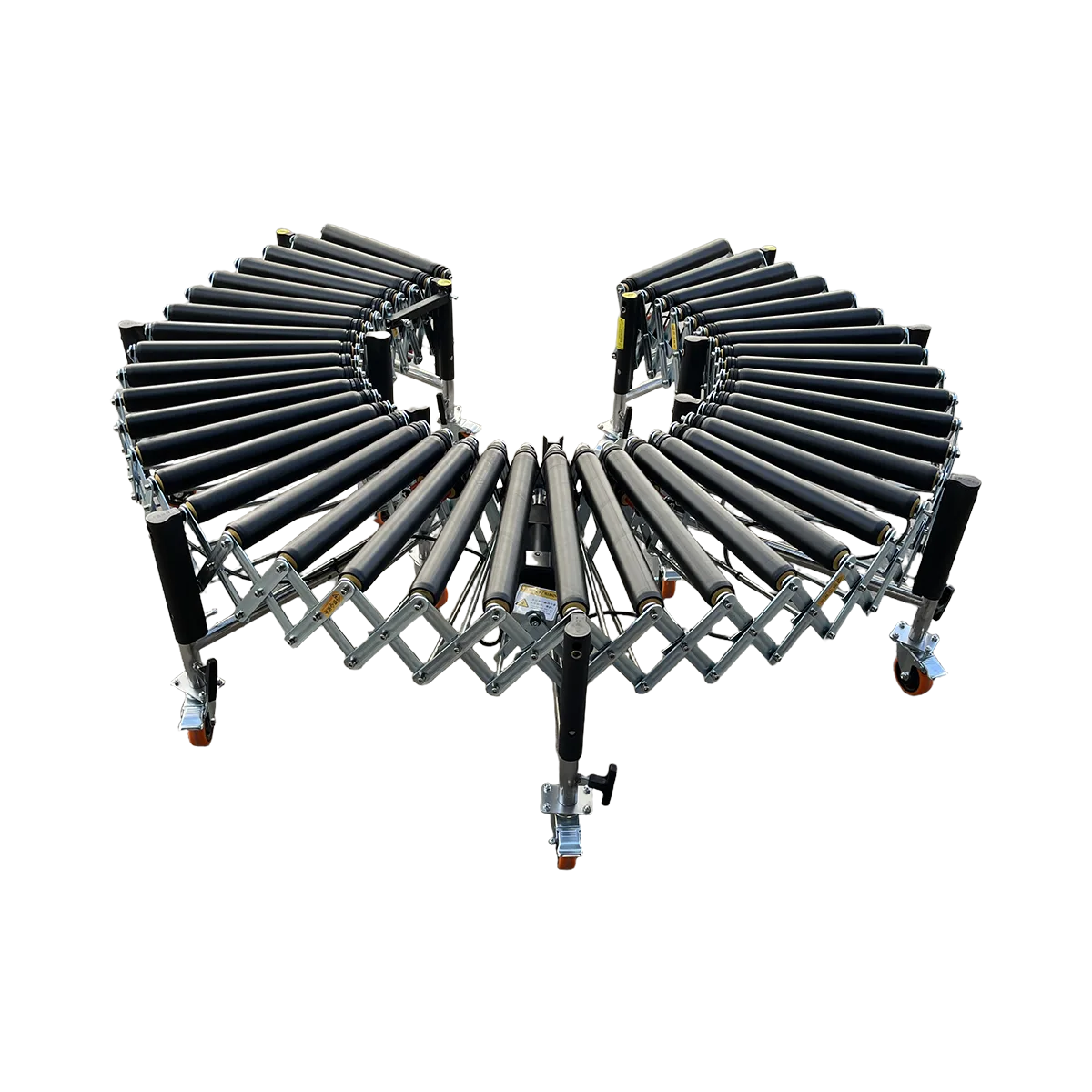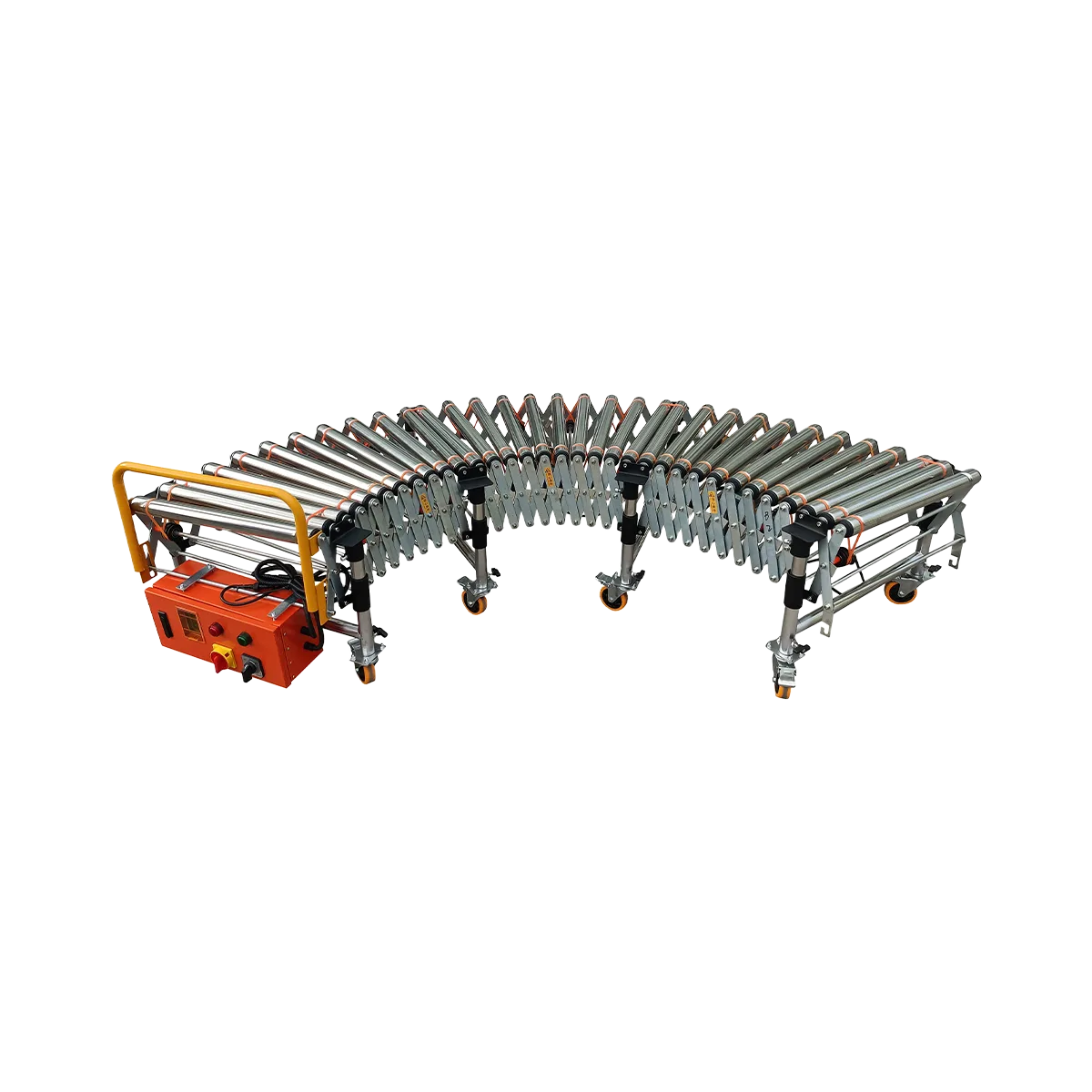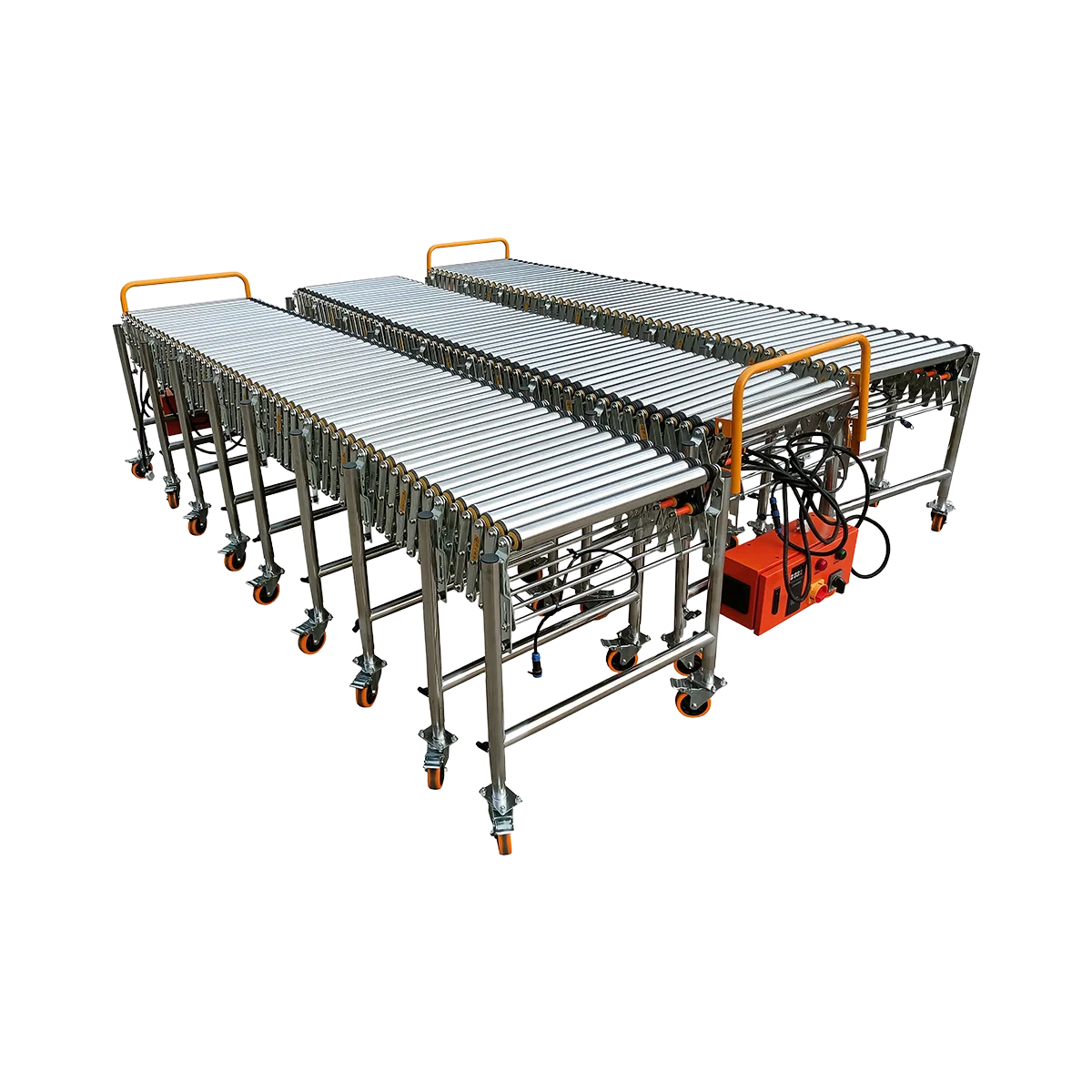Maximizing Small Warehouse Efficiency with Space-Saving Conveyors
Discover how compact conveyor systems can transform your small warehouse operations. Our space saving conveyor solutions maximize efficiency in tight spaces.
Related Products
- Powered Rubber Roller Conveyor – Multi-wedge Belt Driven – 1100 mm/SectionCollapsed Length
560 mm
Extended Length1100 mm
Load Capacity120 kg/m
Applicable GoodsFlat-bottomed Goods
Bagged Goods
- Powered Roller Conveyor – O-shaped Belt Driven – 1500 mm/SectionCollapsed Length
525 mm
Extended Length1500 mm
Load Capacity80 kg/m
Applicable GoodsFlat-bottomed Goods
- Powered Roller Conveyor – Multi-wedge Belt Driven – 2000 mm/SectionCollapsed Length
700 mm
Extended Length2000 mm
Load Capacity100 kg/m
Applicable GoodsFlat-bottomed Goods
- Powered Roller Conveyor – Multi-wedge Belt Driven – 3000 mm/SectionCollapsed Length
1050 mm
Extended Length3000 mm
Load Capacity80 kg/m
Applicable GoodsFlat-bottomed Goods
In today’s competitive logistics landscape, small and medium-sized businesses face a common dilemma: how to achieve the operational efficiency of larger competitors while working within significantly constrained spaces. The challenge of implementing effective material handling solutions in compact warehouses often seems insurmountable, with traditional conveyor systems requiring substantial floor space both during operation and storage.
This space constraint directly impacts productivity, with many smaller operations forced to rely on manual handling or inefficient workflows that create bottlenecks and limit throughput. The consequences extend beyond just slower processing—they include increased labor costs, higher injury risks, and ultimately, reduced competitiveness in a market where speed and efficiency are paramount.
Fortunately, modern space saving conveyor technology offers a compelling solution. These systems are specifically engineered to deliver maximum functionality while occupying minimal space, allowing even the most compact warehouses to implement professional-grade material handling solutions that dramatically improve operational efficiency.
The ‘Accordion’ Advantage: How Flexible Conveyors Multiply Your Reach, Not Your Storage Needs.
The transformative power of accordion conveyor technology lies in its ability to expand dramatically during use while collapsing to a fraction of its operational length for storage. This unique capability creates a fundamental shift in how small warehouses can approach material handling.
The Expansion Principle
At the core of these systems is a cleverly engineered frame that allows for significant extension without sacrificing structural integrity:
- When fully collapsed, the conveyor occupies minimal floor or wall space
- When needed, the system expands to multiple times its storage length
- The expansion/contraction process requires no tools and minimal effort
- The system maintains full functionality and load capacity in its extended state
This expansion capability means a warehouse can store a 12-meter conveyor line in just 2.5 meters of space when not in use—an invaluable advantage for facilities where every square meter matters.
Operational Flexibility
Beyond just saving space, the flexible conveyor for tight spaces creates new operational possibilities:
- Reconfigurable workflows: Easily change conveyor paths to adapt to different processing requirements
- Temporary deployment: Set up conveyor lines only when needed, reclaiming the space for other purposes when not in use
- Scalable implementation: Start with essential sections and expand the system as budget allows
- Multi-purpose utilization: Use the same conveyor for different areas of the warehouse on different days
For small warehouse operators, this flexibility represents a paradigm shift—no longer must they choose between adequate space for inventory and efficient material handling infrastructure. With expandable conveyor technology, they can have both.
Storage Integration
The compact storage footprint of these systems allows for creative integration into existing warehouse layouts:
- Store collapsed conveyors against walls without obstructing walkways
- Hang sections vertically when not in use (with appropriate mounting hardware)
- Tuck units under workstations or shelving during off-hours
- Stack multiple collapsed sections in dedicated storage areas
This integration capability means the conveyor system becomes an enhancement to the warehouse environment rather than a constraint on its limited space.
Feature Deep Dive: Comparing Naili’s Space-Saving Champions
Naili offers several conveyor options designed specifically for space-constrained environments, each with unique advantages for particular applications. Understanding the key differences helps warehouse managers select the optimal solution for their specific needs.
Gravity Skate Wheel Conveyor: The ultimate space-saver with a 1:5 expansion ratio.
The gravity skate wheel conveyor represents the pinnacle of space-saving design in Naili’s product lineup, offering an unmatched combination of compactness and extensibility.
Key specifications:
- Expansion ratio: 1:5 (industry-leading)
- Collapsed length: Just 420mm per section
- Extended length: 2100mm per section
- Weight capacity: 50 kg/m
- Available widths: 500/600/800mm
- Section weight: 14-20kg (depending on width)
The remarkable 1:5 expansion ratio means this system occupies 80% less space when stored compared to its fully operational length. For a small warehouse, this translates to the ability to deploy significant conveyor capacity with minimal impact on storage space.
Design advantages:
- Lightweight construction: Approximately 30% lighter than roller conveyors, making repositioning effortless
- Wheel design: 48mm diameter skate wheels with 608 international standard bearings provide smooth operation with minimal maintenance
- Modular connectivity: Sections connect easily to create custom lengths and configurations
- Height adjustability: Support legs adjust from 450mm to 1500mm to accommodate various working heights
The skate wheel design is particularly well-suited for handling cardboard boxes, plastic containers, and other items with flat, rigid bottoms. The point-contact between wheels and packages reduces friction, allowing for efficient movement with minimal slope requirements.
Powered/Gravity Roller Conveyors: Robust performance with a 1:3 expansion ratio.
While not quite as compact as skate wheel models, Naili’s roller conveyors still offer impressive space efficiency with the advantage of handling a wider range of package types.
Gravity Roller Conveyor specifications:
- Expansion ratio: 1:3
- Collapsed length: 525mm (50mm model) / 485mm (38mm model)
- Extended length: 1500mm (50mm model) / 1700mm (38mm model)
- Weight capacity: 50 kg/m (50mm model) / 50 kg/m (38mm model)
- Available widths: 500/600/800mm
- Section weight: 26-39kg (50mm model) / 20-30kg (38mm model)
Powered Roller Conveyor specifications:
- Expansion ratio: 1:3 (O-belt model) / 2:3 (Multi-wedge belt model)
- Collapsed length: 525mm (O-belt) / 700mm (Multi-wedge belt)
- Extended length: 1500mm (O-belt) / 2000mm (Multi-wedge belt)
- Weight capacity: 80 kg/m (O-belt) / 100 kg/m (Multi-wedge belt)
- Available widths: 500/600/800mm
- Section weight: 31-41kg (O-belt) / varies (Multi-wedge belt)
The roller design provides continuous line contact with packages, offering several distinct advantages:
- Superior support for soft packages: Prevents sagging between support points
- Better stability for heavier items: Distributes weight more evenly
- Smoother transport for irregular bottoms: Accommodates minor surface irregularities
- Reduced risk of package damage: Minimizes pressure points during transport
For warehouses handling diverse product types, particularly those with soft packaging or irregular shapes, the roller conveyor’s 1:3 expansion ratio still delivers significant space savings while providing the necessary handling capabilities.
Comparative Analysis: Finding Your Perfect Balance
When selecting the optimal compact conveyor for your small warehouse, consider these key comparison points:
| Feature | Gravity Skate Wheel | Gravity Roller | Powered Roller |
|---|---|---|---|
| Space Efficiency | ★★★★★ (1:5 ratio) | ★★★☆☆ (1:3 ratio) | ★★★☆☆ (1:3 ratio) |
| Weight Capacity | ★★★☆☆ (50 kg/m) | ★★★☆☆ (50 kg/m) | ★★★★★ (up to 100 kg/m) |
| Package Versatility | ★★★☆☆ (flat-bottomed only) | ★★★★☆ (most types) | ★★★★★ (all types) |
| Ease of Movement | ★★★★★ (lightest weight) | ★★★★☆ (moderate weight) | ★★★☆☆ (heaviest) |
| Power Requirement | ★★★★★ (none) | ★★★★★ (none) | ★★☆☆☆ (requires electricity) |
| Initial Investment | ★★★★★ (lowest) | ★★★★☆ (moderate) | ★★★☆☆ (highest) |
The ideal system often depends on your specific operational requirements:
- For maximum space savings with lightweight packages: Gravity Skate Wheel
- For balanced performance with diverse package types: Gravity Roller
- For powered operation with heavier items: Powered Roller
Many small warehouses benefit from a hybrid approach, using different conveyor types for specific zones based on their particular requirements.
Practical Application: A visual guide to designing a U-shaped workflow in a narrow aisle to minimize movement.
One of the most effective ways to implement warehouse optimization in tight spaces is through a U-shaped workflow design. This approach maximizes conveyor length while minimizing the required floor space, creating an efficient material handling path even in narrow aisles.
Step 1: Assess Your Available Space
Begin by identifying the narrowest aisle or area where you need to establish a workflow:
- Measure the available width (typically 2-3 meters in small warehouses)
- Determine the maximum length available for the U-shaped configuration
- Identify any obstacles or fixed equipment that must be accommodated
- Consider ceiling height if vertical clearance might be an issue
Step 2: Configure Your Conveyor Path
The U-shaped design consists of three primary segments:
- Inbound leg: Where packages enter the workflow
- Position at the start of your process
- Configure height for comfortable loading by operators
- Consider using a powered section here if packages will be traveling uphill
- Turn section: Creates the U-shape
- Implement using 2-4 conveyor sections depending on width
- Set up in a gentle curve rather than sharp angles
- Ensure proper support at connection points
- Outbound leg: Where packages exit the workflow
- Position to deliver packages to their next destination
- Adjust height to match the receiving area or workstation
- Consider a slight downward slope to aid gravity flow
For a typical narrow aisle (2.5m wide), a U-shaped configuration using Gravity Skate Wheel conveyors might include:
- Two 2.1m sections for the inbound leg
- Three sections configured in a curve for the turn
- Two 2.1m sections for the outbound leg
This creates approximately 14.7 meters of conveyor path while occupying only about 5.5 meters of linear floor space—a dramatic improvement in space utilization.
Step 3: Optimize Workflow Ergonomics
With the physical path established, focus on ergonomic considerations:
- Set inbound height at 750-850mm for comfortable loading
- Ensure the turn section maintains appropriate product flow speed
- Position the outbound end at the optimal height for the next process
- Create adequate operator zones at key interaction points
- Implement appropriate slopes (typically 3-6° for skate wheel, 2-5° for roller)
Step 4: Test and Refine
Before finalizing the installation:
- Test with actual product samples to verify flow characteristics
- Adjust slopes as needed to achieve optimal speed
- Verify clearances around the entire path
- Ensure operators can comfortably access all interaction points
The beauty of flexible conveyor for tight spaces is that adjustments are simple—conveyor sections can be easily repositioned, extended, or reconfigured until the optimal workflow is achieved.
Storage Comparison: Showing a Skate Wheel and a Roller conveyor fully retracted, highlighting the footprint difference.
One of the most compelling advantages of expandable conveyor systems is their dramatically reduced storage footprint. This comparison illustrates the practical space-saving benefits of the different systems when not in use.
Gravity Skate Wheel Conveyor Storage Profile
When fully collapsed, a standard 2100mm Gravity Skate Wheel conveyor section shrinks to just 420mm in length—a reduction of 80%. This exceptional compactness creates several practical benefits:
- Vertical storage option: A collapsed section can be stored upright against a wall, occupying just 420mm of wall space and minimal floor area
- Under-counter storage: Collapsed sections can fit beneath standard workbenches or packing tables
- Multi-unit storage: Five collapsed sections (which would extend to over 10 meters when deployed) can be stored in just over 2 meters of shelf space
For a small warehouse, this means a complete conveyor system capable of spanning the entire facility can be tucked away in a storage closet when not needed.
Roller Conveyor Storage Profile
While not quite as compact as the skate wheel version, roller conveyors still offer impressive storage efficiency:
- A 1500mm Gravity Roller conveyor (50mm model) collapses to 525mm—a 65% reduction
- A 1700mm Gravity Roller conveyor (38mm model) collapses to 485mm—a 71% reduction
- A 1500mm Powered Roller conveyor (O-belt model) collapses to 525mm—a 65% reduction
These systems require slightly more storage space than skate wheel models but still deliver substantial space savings compared to fixed conveyor installations.
Practical Storage Solutions
Small warehouses can implement several creative storage approaches for their collapsed conveyor sections:
- Wall-mounted storage racks: Simple brackets that hold collapsed sections vertically against walls
- Under-shelf storage: Utilizing the space beneath existing shelving units
- Mobile storage carts: Wheeled carts designed to hold multiple collapsed sections that can be moved to a designated storage area
- Overhead suspension: In warehouses with adequate ceiling height, collapsed sections can be suspended above work areas
The key advantage is that these storage solutions occupy space that would otherwise be unused, allowing the warehouse to maintain full operational capacity while keeping conveyor systems readily available when needed.
Visual Comparison
To illustrate the dramatic difference in storage requirements:
- A 10-meter skate wheel conveyor line requires just 2 meters of storage space
- The same length in roller conveyor requires approximately 3.5 meters
- A fixed, non-collapsible conveyor would require the full 10 meters plus access clearance
For space-constrained operations, this difference can be the determining factor in whether implementing a conveyor system is feasible at all.
Don’t let space limit your efficiency. Choose a conveyor that expands your capabilities, not your clutter.
In the world of small warehouse operations, space constraints have traditionally forced difficult compromises between storage capacity, operational efficiency, and working conditions. The limited footprint available meant that many smaller businesses simply couldn’t implement the material handling solutions that would allow them to compete effectively with larger operations.
Modern space saving conveyor technology has fundamentally changed this equation. With expansion ratios of up to 1:5, these systems deliver professional-grade material handling capabilities without demanding dedicated floor space when not in use. This breakthrough allows even the most space-constrained facilities to implement efficient workflows that dramatically improve throughput, reduce labor requirements, and enhance ergonomics.
The benefits extend beyond just operational improvements. By implementing these flexible systems, small warehouses can:
- Increase throughput without expanding facilities: Process more orders in the same physical space
- Reduce labor costs: Minimize manual handling and walking distances
- Improve worker safety: Decrease lifting injuries and repetitive strain
- Enhance adaptability: Quickly reconfigure for different product types or seasonal demands
- Scale operations gradually: Add conveyor capacity incrementally as business grows
The key to success lies in selecting the right system for your specific needs. For maximum space efficiency with standard packages, the Gravity Skate Wheel conveyor’s 1:5 expansion ratio makes it the clear choice. For operations handling diverse package types, the Gravity Roller conveyor offers an excellent balance of space savings and versatility. And for situations requiring powered operation, the expandable Powered Roller conveyor delivers motorized performance without permanent space commitment.
By embracing these innovative solutions, small warehouse operators can transform their limited space from a constraint into a competitive advantage. The ability to deploy, reconfigure, and store conveyor systems on demand creates a level of operational flexibility that even larger facilities might envy.
Don’t let your warehouse’s size determine its capabilities. With the right compact conveyor solution, you can maximize efficiency, improve working conditions, and build a material handling infrastructure that grows with your business—all without expanding your physical footprint.
Frequently Asked Questions
What is the minimum ceiling height required for using expandable conveyors in a small warehouse?
For most applications, a minimum ceiling height of 2.2 meters is sufficient. The adjustable support legs on Naili’s conveyors can be set as low as 450mm, allowing the conveyor bed to sit at a comfortable working height even in spaces with lower ceilings. For optimal ergonomics, a working height of 750-850mm is recommended for most operations.
How quickly can these conveyors be reconfigured for different workflows?
A typical reconfiguration can be completed in 10-15 minutes. This includes collapsing the conveyor, moving it to a new location, extending it to the desired length, and adjusting the height. No tools are required for basic setup changes, though a wrench may be needed for significant height adjustments. With practice, a team of two workers can transform the entire warehouse layout in under an hour.
Can space-saving conveyors handle the same volume as fixed conveyor systems?
Yes, when deployed, these conveyors offer the same throughput capacity as fixed systems of equivalent length. The primary difference is that these systems can be stored away when not needed, unlike fixed installations that permanently occupy valuable floor space.
What maintenance is required for expandable conveyor systems?
Maintenance requirements are minimal. For gravity systems, regular checks of wheel or roller bearings (monthly), frame connections (quarterly), and support leg adjustments (as needed) are typically sufficient. The expandable frame design may require occasional lubrication at pivot points if operation becomes stiff. With proper care, these systems typically provide 5-10+ years of reliable service.
How do I determine whether to choose skate wheel or roller conveyors for my small warehouse?
The decision should be based primarily on your package types. Choose skate wheel conveyors if you primarily handle packages with rigid, flat bottoms and prioritize maximum space savings. Select roller conveyors if you handle a variety of package types, including softer items or irregular shapes, and can accommodate the slightly larger storage footprint. For many operations, a hybrid approach works best—using skate wheel conveyors for standard packages and roller conveyors for areas handling more diverse product types.
Table of Contents
Recent Posts
Optimize hardware store logistics with the right building supply conveyor systems. Our guide to tool distribution systems enhances retail warehouse automation for efficient operations.
Optimize your medical supply logistics with efficient gravity conveyor systems. Learn how to safely handle healthcare products while improving your hospital supply chain operations.
Discover how a sports equipment conveyor system can streamline your athletic gear logistics. Flexible conveyor solutions for all shapes and sizes of sporting goods.




